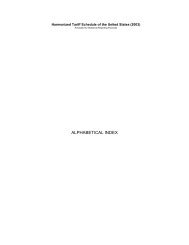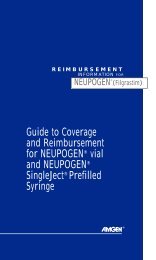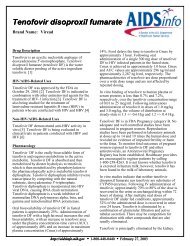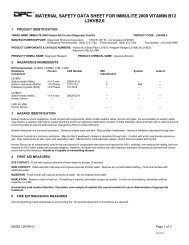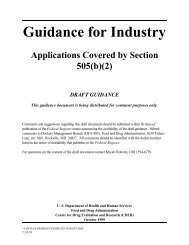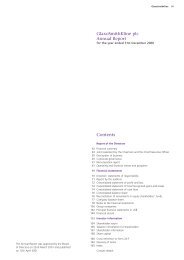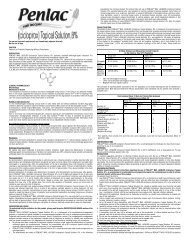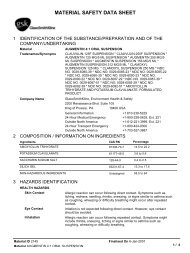CEFTIN® Tablets
CEFTIN® Tablets
CEFTIN® Tablets
You also want an ePaper? Increase the reach of your titles
YUMPU automatically turns print PDFs into web optimized ePapers that Google loves.
CEFTIN ® <strong>Tablets</strong><br />
(cefuroxime axetil tablets)<br />
PRESCRIBING INFORMATION<br />
CEFTIN ® for Oral Suspension<br />
(cefuroxime axetil powder for oral suspension)<br />
DESCRIPTION<br />
CEFTIN <strong>Tablets</strong> and CEFTIN for Oral Suspension contain cefuroxime as cefuroxime axetil.<br />
CEFTIN is a semisynthetic, broad-spectrum cephalosporin antibiotic for oral administration.<br />
Chemically, cefuroxime axetil, the 1-(acetyloxy) ethyl ester of cefuroxime, is (RS)-1-<br />
hydroxyethyl (6R,7R)-7-[2-(2-furyl)glyoxylamido]-3-(hydroxymethyl)-8-oxo-5-thia-1-<br />
azabicyclo[4.2.0]oct-2-ene-2-carboxylate, 7 2 -(Z)-(O-methyl-oxime), 1-acetate 3-carbamate. Its<br />
molecular formula is C 20 H 22 N 4 O 10 S, and it has a molecular weight of 510.48.<br />
Cefuroxime axetil is in the amorphous form and has the following structural formula:<br />
CEFTIN <strong>Tablets</strong> are film-coated and contain the equivalent of 125, 250, or 500 mg of<br />
cefuroxime as cefuroxime axetil. CEFTIN <strong>Tablets</strong> contain the inactive ingredients colloidal silicon<br />
dioxide, croscarmellose sodium, FD&C Blue No. 1 (250- and 500-mg tablets only), hydrogenated<br />
vegetable oil, hydroxypropyl methylcellulose, methylparaben, microcrystalline cellulose, propylene<br />
glycol, propylparaben, sodium benzoate (125-mg tablets only), sodium lauryl sulfate, and titanium<br />
dioxide.<br />
CEFTIN for Oral Suspension, when reconstituted with water, provides the equivalent of 125 mg<br />
or 250 mg of cefuroxime (as cefuroxime axetil) per 5 mL of suspension. CEFTIN for Oral<br />
Suspension contains the inactive ingredients povidone K30, stearic acid, sucrose, and tutti-frutti<br />
flavoring.<br />
CLINICAL PHARMACOLOGY<br />
Absorption and Metabolism: After oral administration, cefuroxime axetil is absorbed from the<br />
gastrointestinal tract and rapidly hydrolyzed by nonspecific esterases in the intestinal mucosa and<br />
blood to cefuroxime. Cefuroxime is subsequently distributed throughout the extracellular fluids.<br />
The axetil moiety is metabolized to acetaldehyde and acetic acid.<br />
Pharmacokinetics: Approximately 50% of serum cefuroxime is bound to protein. Serum<br />
pharmacokinetic parameters for CEFTIN <strong>Tablets</strong> and CEFTIN for Oral Suspension are shown in<br />
Tables 1 and 2.
CEFTIN ® <strong>Tablets</strong> (cefuroxime axetil tablets)<br />
CEFTIN ® for Oral Suspension (cefuroxime axetil powder for oral suspension)<br />
Table 1. Postprandial Pharmacokinetics of Cefuroxime Administered as CEFTIN<br />
<strong>Tablets</strong> to Adults*<br />
Dose †<br />
(Cefuroxime<br />
Equivalent)<br />
Peak Plasma<br />
Concentration<br />
(mcg/mL)<br />
Time of Peak<br />
Plasma<br />
Concentration (hr)<br />
Mean<br />
Elimination<br />
Half-Life (hr)<br />
AUC<br />
(mcg-hr mL)<br />
125 mg 2.1 2.2 1.2 6.7<br />
250 mg 4.1 2.5 1.2 12.9<br />
500 mg 7.0 3.0 1.2 27.4<br />
1,000 mg 13.6 2.5 1.3 50.0<br />
*Mean values of 12 healthy adult volunteers.<br />
† Drug administered immediately after a meal.<br />
Table 2. Postprandial Pharmacokinetics of Cefuroxime Administered as CEFTIN for<br />
Oral Suspension to Pediatric Patients*<br />
Dose †<br />
(Cefuroxime<br />
Equivalent) n<br />
Peak Plasma<br />
Concentration<br />
(mcg/mL)<br />
Time of Peak<br />
Plasma<br />
Concentration<br />
(hr)<br />
Mean<br />
Elimination<br />
Half-Life<br />
(hr)<br />
AUC<br />
(mcg-hr mL)<br />
10 mg/kg 8 3.3 3.6 1.4 12.4<br />
15 mg/kg 12 5.1 2.7 1.9 22.5<br />
20 mg/kg 8 7.0 3.1 1.9 32.8<br />
*Mean age = 23 months.<br />
† Drug administered with milk or milk products.<br />
Comparative Pharmacokinetic Properties: A 250 mg/5 mL-dose of CEFTIN Suspension is<br />
bioequivalent to 2 times 125 mg/5 mL-dose of CEFTIN Suspension when administered with food<br />
(see Table 3). CEFTIN for Oral Suspension was not bioequivalent to CEFTIN <strong>Tablets</strong> when<br />
tested in healthy adults. The tablet and powder for oral suspension formulations are NOT<br />
substitutable on a milligram-per-milligram basis. The area under the curve for the suspension<br />
averaged 91% of that for the tablet, and the peak plasma concentration for the suspension averaged<br />
71% of the peak plasma concentration of the tablets. Therefore, the safety and effectiveness of both<br />
the tablet and oral suspension formulations had to be established in separate clinical trials.<br />
Table 3. Pharmacokinetics of Cefuroxime Administered as 250 mg/5 mL or 2 x<br />
125 mg/5 mL CEFTIN for Oral Suspension to Adults* With Food<br />
Dose<br />
(Cefuroxime<br />
Equivalent)<br />
Peak Plasma<br />
Concentration<br />
(mcg/mL)<br />
Time of Peak<br />
Plasma<br />
Concentration (hr)<br />
Mean<br />
Elimination<br />
Half-Life (hr)<br />
AUC<br />
(mcg-hr mL)<br />
250 mg/5 mL 2.23 3 1.40 8.92<br />
2 x 125 mg/5 mL 2.37 3 1.44 9.75<br />
*Mean values of 18 healthy adult volunteers.<br />
Food Effect on Pharmacokinetics: Absorption of the tablet is greater when taken after food<br />
(absolute bioavailability of CEFTIN <strong>Tablets</strong> increases from 37% to 52%). Despite this difference in<br />
2
CEFTIN ® <strong>Tablets</strong> (cefuroxime axetil tablets)<br />
CEFTIN ® for Oral Suspension (cefuroxime axetil powder for oral suspension)<br />
absorption, the clinical and bacteriologic responses of patients were independent of food intake at<br />
the time of tablet administration in 2 studies where this was assessed.<br />
All pharmacokinetic and clinical effectiveness and safety studies in pediatric patients using the<br />
suspension formulation were conducted in the fed state. No data are available on the absorption<br />
kinetics of the suspension formulation when administered to fasted pediatric patients.<br />
Renal Excretion: Cefuroxime is excreted unchanged in the urine; in adults, approximately 50%<br />
of the administered dose is recovered in the urine within 12 hours. The pharmacokinetics of<br />
cefuroxime in the urine of pediatric patients have not been studied at this time. Until further data are<br />
available, the renal pharmacokinetic properties of cefuroxime axetil established in adults should not<br />
be extrapolated to pediatric patients.<br />
Because cefuroxime is renally excreted, the serum half-life is prolonged in patients with reduced<br />
renal function. In a study of 20 elderly patients (mean age = 83.9 years) having a mean creatinine<br />
clearance of 34.9 mL/min, the mean serum elimination half-life was 3.5 hours. Despite the lower<br />
elimination of cefuroxime in geriatric patients, dosage adjustment based on age is not necessary (see<br />
PRECAUTIONS: Geriatric Use).<br />
Microbiology: The in vivo bactericidal activity of cefuroxime axetil is due to cefuroxime's<br />
binding to essential target proteins and the resultant inhibition of cell-wall synthesis.<br />
Cefuroxime has bactericidal activity against a wide range of common pathogens, including many<br />
beta-lactamase–producing strains. Cefuroxime is stable to many bacterial beta-lactamases,<br />
especially plasmid-mediated enzymes that are commonly found in enterobacteriaceae.<br />
Cefuroxime has been demonstrated to be active against most strains of the following<br />
microorganisms both in vitro and in clinical infections as described in the INDICATIONS AND<br />
USAGE section (see INDICATIONS AND USAGE section).<br />
Aerobic Gram-Positive Microorganisms:<br />
Staphylococcus aureus (including beta-lactamase–producing strains)<br />
Streptococcus pneumoniae<br />
Streptococcus pyogenes<br />
Aerobic Gram-Negative Microorganisms:<br />
Escherichia coli<br />
Haemophilus influenzae (including beta-lactamase–producing strains)<br />
Haemophilus parainfluenzae<br />
Klebsiella pneumoniae<br />
Moraxella catarrhalis (including beta-lactamase–producing strains)<br />
Neisseria gonorrhoeae (including beta-lactamase–producing strains)<br />
Spirochetes:<br />
Borrelia burgdorferi<br />
Cefuroxime has been shown to be active in vitro against most strains of the following<br />
microorganisms; however, the clinical significance of these findings is unknown.<br />
Cefuroxime exhibits in vitro minimum inhibitory concentrations (MICs) of 4.0 mcg/mL or less<br />
(systemic susceptible breakpoint) against most (≥90%) strains of the following microorganisms;<br />
however, the safety and effectiveness of cefuroxime in treating clinical infections due to these<br />
microorganisms have not been established in adequate and well-controlled trials.<br />
Aerobic Gram-Positive Microorganisms:<br />
Staphylococcus epidermidis<br />
Staphylococcus saprophyticus<br />
3
CEFTIN ® <strong>Tablets</strong> (cefuroxime axetil tablets)<br />
CEFTIN ® for Oral Suspension (cefuroxime axetil powder for oral suspension)<br />
Streptococcus agalactiae<br />
NOTE: Certain strains of enterococci, e.g., Enterococcus faecalis (formerly Streptococcus faecalis),<br />
are resistant to cefuroxime. Methicillin-resistant staphylococci are resistant to cefuroxime.<br />
Aerobic Gram-Negative Microorganisms:<br />
Morganella morganii<br />
Proteus inconstans<br />
Proteus mirabilis<br />
Providencia rettgeri<br />
NOTE: Pseudomonas spp., Campylobacter spp., Acinetobacter calcoaceticus, and most strains of<br />
Serratia spp. and Proteus vulgaris are resistant to most first- and second-generation cephalosporins.<br />
Some strains of Morganella morganii, Enterobacter cloacae, and Citrobacter spp. have been shown<br />
by in vitro tests to be resistant to cefuroxime and other cephalosporins.<br />
Anaerobic Microorganisms:<br />
Peptococcus niger<br />
NOTE: Most strains of Clostridium difficile and Bacteroides fragilis are resistant to cefuroxime.<br />
Susceptibility Tests: Dilution Techniques: Quantitative methods that are used to determine<br />
MICs provide reproducible estimates of the susceptibility of bacteria to antimicrobial compounds.<br />
One such standardized procedure uses a standardized dilution method 1 (broth, agar, or<br />
microdilution) or equivalent with cefuroxime powder. The MIC values obtained should be<br />
interpreted according to the following criteria:<br />
MIC (mcg/mL) Interpretation<br />
≤4<br />
(S) Susceptible<br />
8-16 (I) Intermediate<br />
≥32<br />
(R) Resistant<br />
A report of "Susceptible" indicates that the pathogen, if in the blood, is likely to be inhibited by<br />
usually achievable concentrations of the antimicrobial compound in blood. A report of<br />
"Intermediate" indicates that inhibitory concentrations of the antibiotic may be achieved if high<br />
dosage is used or if the infection is confined to tissues or fluids in which high antibiotic<br />
concentrations are attained. This category also provides a buffer zone that prevents small,<br />
uncontrolled technical factors from causing major discrepancies in interpretation. A report of<br />
"Resistant" indicates that usually achievable concentrations of the antimicrobial compound in the<br />
blood are unlikely to be inhibitory and that other therapy should be selected.<br />
Standardized susceptibility test procedures require the use of laboratory control microorganisms.<br />
Standard cefuroxime powder should give the following MIC values:<br />
Microorganism<br />
MIC (mcg/mL)<br />
Escherichia coli ATCC 25922 2-8<br />
Staphylococcus aureus ATCC 29213 0.5-2<br />
Diffusion Techniques: Quantitative methods that require measurement of zone diameters<br />
provide estimates of the susceptibility of bacteria to antimicrobial compounds. One such<br />
standardized procedure 2 that has been recommended (for use with disks) to test the susceptibility of<br />
4
CEFTIN ® <strong>Tablets</strong> (cefuroxime axetil tablets)<br />
CEFTIN ® for Oral Suspension (cefuroxime axetil powder for oral suspension)<br />
microorganisms to cefuroxime uses the 30-mcg cefuroxime disk. Interpretation involves correlation<br />
of the diameter obtained in the disk test with the MIC for cefuroxime.<br />
Reports from the laboratory providing results of the standard single-disk susceptibility test with a<br />
30-mcg cefuroxime disk should be interpreted according to the following criteria:<br />
Zone Diameter (mm) Interpretation<br />
≥23<br />
(S) Susceptible<br />
15-22 (I) Intermediate<br />
≤14<br />
(R) Resistant<br />
Interpretation should be as stated above for results using dilution techniques.<br />
As with standard dilution techniques, diffusion methods require the use of laboratory control<br />
microorganisms. The 30-mcg cefuroxime disk provides the following zone diameters in these<br />
laboratory test quality control strains:<br />
Microorganism<br />
Zone Diameter (mm)<br />
Escherichia coli ATCC 25922 20-26<br />
Staphylococcus aureus ATCC 25923 27-35<br />
INDICATIONS AND USAGE<br />
NOTE: CEFTIN TABLETS AND CEFTIN FOR ORAL SUSPENSION ARE NOT<br />
BIOEQUIVALENT AND ARE NOT SUBSTITUTABLE ON A<br />
MILLIGRAM-PER-MILLIGRAM BASIS (SEE CLINICAL PHARMACOLOGY).<br />
CEFTIN <strong>Tablets</strong>: CEFTIN <strong>Tablets</strong> are indicated for the treatment of patients with mild to<br />
moderate infections caused by susceptible strains of the designated microorganisms in the<br />
conditions listed below:<br />
1. Pharyngitis/Tonsillitis caused by Streptococcus pyogenes.<br />
NOTE: The usual drug of choice in the treatment and prevention of streptococcal infections,<br />
including the prophylaxis of rheumatic fever, is penicillin given by the intramuscular route.<br />
CEFTIN <strong>Tablets</strong> are generally effective in the eradication of streptococci from the nasopharynx;<br />
however, substantial data establishing the efficacy of cefuroxime in the subsequent prevention of<br />
rheumatic fever are not available. Please also note that in all clinical trials, all isolates had to be<br />
sensitive to both penicillin and cefuroxime. There are no data from adequate and well-controlled<br />
trials to demonstrate the effectiveness of cefuroxime in the treatment of penicillin-resistant<br />
strains of Streptococcus pyogenes.<br />
2. Acute Bacterial Otitis Media caused by Streptococcus pneumoniae, Haemophilus influenzae<br />
(including beta-lactamase–producing strains), Moraxella catarrhalis (including beta-lactamase–<br />
producing strains), or Streptococcus pyogenes.<br />
3. Acute Bacterial Maxillary Sinusitis caused by Streptococcus pneumoniae or Haemophilus<br />
influenzae (non-beta-lactamase–producing strains only). (See CLINICAL STUDIES section.)<br />
NOTE: In view of the insufficient numbers of isolates of beta-lactamase–producing strains of<br />
Haemophilus influenzae and Moraxella catarrhalis that were obtained from clinical trials with<br />
CEFTIN <strong>Tablets</strong> for patients with acute bacterial maxillary sinusitis, it was not possible to<br />
adequately evaluate the effectiveness of CEFTIN <strong>Tablets</strong> for sinus infections known, suspected,<br />
5
CEFTIN ® <strong>Tablets</strong> (cefuroxime axetil tablets)<br />
CEFTIN ® for Oral Suspension (cefuroxime axetil powder for oral suspension)<br />
or considered potentially to be caused by beta-lactamase–producing Haemophilus influenzae or<br />
Moraxella catarrhalis.<br />
4. Acute Bacterial Exacerbations of Chronic Bronchitis and Secondary Bacterial Infections of<br />
Acute Bronchitis caused by Streptococcus pneumoniae, Haemophilus influenzae<br />
(beta-lactamase negative strains), or Haemophilus parainfluenzae (beta-lactamase negative<br />
strains). (See DOSAGE AND ADMINISTRATION section and CLINICAL STUDIES section.)<br />
5. Uncomplicated Skin and Skin-Structure Infections caused by Staphylococcus aureus<br />
(including beta-lactamase–producing strains) or Streptococcus pyogenes.<br />
6. Uncomplicated Urinary Tract Infections caused by Escherichia coli or Klebsiella pneumoniae.<br />
7. Uncomplicated Gonorrhea, urethral and endocervical, caused by penicillinase-producing and<br />
non-penicillinase–producing strains of Neisseria gonorrhoeae and uncomplicated gonorrhea,<br />
rectal, in females, caused by non-penicillinase–producing strains of Neisseria gonorrhoeae.<br />
8. Early Lyme Disease (erythema migrans) caused by Borrelia burgdorferi.<br />
CEFTIN for Oral Suspension: CEFTIN for Oral Suspension is indicated for the treatment of<br />
pediatric patients 3 months to 12 years of age with mild to moderate infections caused by<br />
susceptible strains of the designated microorganisms in the conditions listed below. The safety and<br />
effectiveness of CEFTIN for Oral Suspension in the treatment of infections other than those<br />
specifically listed below have not been established either by adequate and well-controlled trials or<br />
by pharmacokinetic data with which to determine an effective and safe dosing regimen.<br />
1. Pharyngitis/Tonsillitis caused by Streptococcus pyogenes.<br />
NOTE: The usual drug of choice in the treatment and prevention of streptococcal infections,<br />
including the prophylaxis of rheumatic fever, is penicillin given by the intramuscular route.<br />
CEFTIN for Oral Suspension is generally effective in the eradication of streptococci from the<br />
nasopharynx; however, substantial data establishing the efficacy of cefuroxime in the subsequent<br />
prevention of rheumatic fever are not available. Please also note that in all clinical trials, all<br />
isolates had to be sensitive to both penicillin and cefuroxime. There are no data from adequate<br />
and well-controlled trials to demonstrate the effectiveness of cefuroxime in the treatment of<br />
penicillin-resistant strains of Streptococcus pyogenes.<br />
2. Acute Bacterial Otitis Media caused by Streptococcus pneumoniae, Haemophilus influenzae<br />
(including beta-lactamase–producing strains), Moraxella catarrhalis (including beta-lactamase–<br />
producing strains), or Streptococcus pyogenes.<br />
3. Impetigo caused by Staphylococcus aureus (including beta-lactamase–producing strains) or<br />
Streptococcus pyogenes.<br />
Culture and susceptibility testing should be performed when appropriate to determine<br />
susceptibility of the causative microorganism(s) to cefuroxime. Therapy may be started while<br />
awaiting the results of this testing. Antimicrobial therapy should be appropriately adjusted<br />
according to the results of such testing.<br />
CONTRAINDICATIONS<br />
CEFTIN products are contraindicated in patients with known allergy to the cephalosporin group<br />
of antibiotics.<br />
WARNINGS<br />
6
CEFTIN ® <strong>Tablets</strong> (cefuroxime axetil tablets)<br />
CEFTIN ® for Oral Suspension (cefuroxime axetil powder for oral suspension)<br />
CEFTIN TABLETS AND CEFTIN FOR ORAL SUSPENSION ARE NOT<br />
BIOEQUIVALENT AND ARE THEREFORE NOT SUBSTITUTABLE ON A<br />
MILLIGRAM-PER-MILLIGRAM BASIS (SEE CLINICAL PHARMACOLOGY).<br />
BEFORE THERAPY WITH CEFTIN PRODUCTS IS INSTITUTED, CAREFUL<br />
INQUIRY SHOULD BE MADE TO DETERMINE WHETHER THE PATIENT HAS HAD<br />
PREVIOUS HYPERSENSITIVITY REACTIONS TO CEFTIN PRODUCTS, OTHER<br />
CEPHALOSPORINS, PENICILLINS, OR OTHER DRUGS. IF THIS PRODUCT IS TO BE<br />
GIVEN TO PENICILLIN-SENSITIVE PATIENTS, CAUTION SHOULD BE EXERCISED<br />
BECAUSE CROSS-HYPERSENSITIVITY AMONG BETA-LACTAM ANTIBIOTICS HAS<br />
BEEN CLEARLY DOCUMENTED AND MAY OCCUR IN UP TO 10% OF PATIENTS<br />
WITH A HISTORY OF PENICILLIN ALLERGY. IF A CLINICALLY SIGNIFICANT<br />
ALLERGIC REACTION TO CEFTIN PRODUCTS OCCURS, DISCONTINUE THE DRUG<br />
AND INSTITUTE APPROPRIATE THERAPY. SERIOUS ACUTE HYPERSENSITIVITY<br />
REACTIONS MAY REQUIRE TREATMENT WITH EPINEPHRINE AND OTHER<br />
EMERGENCY MEASURES, INCLUDING OXYGEN, INTRAVENOUS FLUIDS,<br />
INTRAVENOUS ANTIHISTAMINES, CORTICOSTEROIDS, PRESSOR AMINES, AND<br />
AIRWAY MANAGEMENT, AS CLINICALLY INDICATED.<br />
Pseudomembranous colitis has been reported with nearly all antibacterial agents, including<br />
cefuroxime, and may range from mild to life threatening. Therefore, it is important to<br />
consider this diagnosis in patients who present with diarrhea subsequent to the<br />
administration of antibacterial agents.<br />
Treatment with antibacterial agents alters normal flora of the colon and may permit overgrowth<br />
of clostridia. Studies indicate that a toxin produced by Clostridium difficile is one primary cause of<br />
antibiotic-associated colitis.<br />
After the diagnosis of pseudomembranous colitis has been established, appropriate therapeutic<br />
measures should be initiated. Mild cases of pseudomembranous colitis usually respond to drug<br />
discontinuation alone. In moderate to severe cases, consideration should be given to management<br />
with fluids and electrolytes, protein supplementation, and treatment with an antibacterial drug<br />
effective against Clostridium difficile.<br />
PRECAUTIONS<br />
General: As with other broad-spectrum antibiotics, prolonged administration of cefuroxime axetil<br />
may result in overgrowth of nonsusceptible microorganisms. If superinfection occurs during<br />
therapy, appropriate measures should be taken.<br />
Cephalosporins, including cefuroxime axetil, should be given with caution to patients receiving<br />
concurrent treatment with potent diuretics because these diuretics are suspected of adversely<br />
affecting renal function.<br />
Cefuroxime axetil, as with other broad-spectrum antibiotics, should be prescribed with caution in<br />
individuals with a history of colitis. The safety and effectiveness of cefuroxime axetil have not been<br />
established in patients with gastrointestinal malabsorption. Patients with gastrointestinal<br />
malabsorption were excluded from participating in clinical trials of cefuroxime axetil.<br />
Cephalosporins may be associated with a fall in prothrombin activity. Those at risk include<br />
patients with renal or hepatic impairment or poor nutritional state, as well as patients receiving a<br />
protracted course of antimicrobial therapy, and patients previously stabilized on anticoagulant<br />
7
CEFTIN ® <strong>Tablets</strong> (cefuroxime axetil tablets)<br />
CEFTIN ® for Oral Suspension (cefuroxime axetil powder for oral suspension)<br />
therapy. Prothrombin time should be monitored in patients at risk and exogenous Vitamin K<br />
administered as indicated.<br />
Information for Patients/Caregivers (Pediatric): 1. During clinical trials, the tablet was<br />
tolerated by pediatric patients old enough to swallow the cefuroxime axetil tablet whole. The<br />
crushed tablet has a strong, persistent, bitter taste and should not be administered to pediatric<br />
patients in this manner. Pediatric patients who cannot swallow the tablet whole should receive the<br />
oral suspension.<br />
2. Discontinuation of therapy due to taste and/or problems of administering this drug occurred in<br />
1.4% of pediatric patients given the oral suspension. Complaints about taste (which may impair<br />
compliance) occurred in 5% of pediatric patients.<br />
Drug/Laboratory Test Interactions: A false-positive reaction for glucose in the urine may<br />
occur with copper reduction tests (Benedict's or Fehling's solution or with CLINITEST ® tablets),<br />
but not with enzyme-based tests for glycosuria (e.g., CLINISTIX ® ). As a false-negative result may<br />
occur in the ferricyanide test, it is recommended that either the glucose oxidase or hexokinase<br />
method be used to determine blood/plasma glucose levels in patients receiving cefuroxime axetil.<br />
The presence of cefuroxime does not interfere with the assay of serum and urine creatinine by the<br />
alkaline picrate method.<br />
Drug/Drug Interactions: Concomitant administration of probenecid with cefuroxime axetil<br />
tablets increases the area under the serum concentration versus time curve by 50%. The peak serum<br />
cefuroxime concentration after a 1.5-g single dose is greater when taken with 1 g of probenecid<br />
(mean = 14.8 mcg/mL) than without probenecid (mean = 12.2 mcg/mL).<br />
Drugs that reduce gastric acidity may result in a lower bioavailability of CEFTIN compared with<br />
that of fasting state and tend to cancel the effect of postprandial absorption.<br />
Carcinogenesis, Mutagenesis, Impairment of Fertility: Although lifetime studies in<br />
animals have not been performed to evaluate carcinogenic potential, no mutagenic activity was<br />
found for cefuroxime axetil in a battery of bacterial mutation tests. Positive results were obtained in<br />
an in vitro chromosome aberration assay, however, negative results were found in an in vivo<br />
micronucleus test at doses up to 1.5 g/kg. Reproduction studies in rats at doses up to<br />
1,000 mg/kg/day (9 times the recommended maximum human dose based on mg/m 2 ) have revealed<br />
no impairment of fertility.<br />
Pregnancy: Teratogenic Effects: Pregnancy Category B. Reproduction studies have been<br />
performed in mice at doses up to 3,200 mg/kg/day (14 times the recommended maximum human<br />
dose based on mg/m 2 ) and in rats at doses up to 1,000 mg/kg/day (9 times the recommended<br />
maximum human dose based on mg/m 2 ) and have revealed no evidence of impaired fertility or harm<br />
to the fetus due to cefuroxime axetil. There are, however, no adequate and well-controlled studies in<br />
pregnant women. Because animal reproduction studies are not always predictive of human response,<br />
this drug should be used during pregnancy only if clearly needed.<br />
Labor and Delivery: Cefuroxime axetil has not been studied for use during labor and delivery.<br />
Nursing Mothers: Because cefuroxime is excreted in human milk, consideration should be given<br />
to discontinuing nursing temporarily during treatment with cefuroxime axetil.<br />
Pediatric Use: The safety and effectiveness of CEFTIN have been established for pediatric<br />
patients aged 3 months to 12 years for acute bacterial maxillary sinusitis based upon its approval in<br />
adults. Use of CEFTIN in pediatric patients is supported by pharmacokinetic and safety data in<br />
adults and pediatric patients, and by clinical and microbiological data from adequate and<br />
well-controlled studies of the treatment of acute bacterial maxillary sinusitis in adults and of acute<br />
8
CEFTIN ® <strong>Tablets</strong> (cefuroxime axetil tablets)<br />
CEFTIN ® for Oral Suspension (cefuroxime axetil powder for oral suspension)<br />
otitis media with effusion in pediatric patients. It is also supported by post-marketing adverse events<br />
surveillance (see CLINICAL PHARMACOLOGY, INDICATIONS AND USAGE, ADVERSE<br />
REACTIONS, DOSAGE AND ADMINISTRATION, and CLINICAL STUDIES).<br />
Geriatric Use: Of the total number of subjects who received cefuroxime axetil in 20 clinical<br />
studies of CEFTIN, 375 were 65 and over while 151 were 75 and over. No overall differences in<br />
safety or effectiveness were observed between these subjects and younger adult subjects. The<br />
geriatric patients reported somewhat fewer gastrointestinal events and less frequent vaginal<br />
candidiasis compared with patients aged 12 to 64 years old; however, no clinically significant<br />
differences were reported between the elderly and younger adult patients. Other reported clinical<br />
experience has not identified differences in responses between the elderly and younger adult<br />
patients.<br />
ADVERSE REACTIONS<br />
CEFTIN TABLETS IN CLINICAL TRIALS: Multiple-Dose Dosing Regimens: 7 to<br />
10 Days Dosing: Using multiple doses of cefuroxime axetil tablets, 912 patients were treated<br />
with the recommended dosages of cefuroxime axetil (125 to 500 mg twice a day). There were no<br />
deaths or permanent disabilities thought related to drug toxicity. Twenty (2.2%) patients<br />
discontinued medication due to adverse events thought by the investigators to be possibly, probably,<br />
or almost certainly related to drug toxicity. Seventeen (85%) of the 20 patients who discontinued<br />
therapy did so because of gastrointestinal disturbances, including diarrhea, nausea, vomiting, and<br />
abdominal pain. The percentage of cefuroxime axetil tablet-treated patients who discontinued study<br />
drug because of adverse events was very similar at daily doses of 1,000, 500, and 250 mg (2.3%,<br />
2.1%, and 2.2%, respectively). However, the incidence of gastrointestinal adverse events increased<br />
with the higher recommended doses.<br />
The following adverse events were thought by the investigators to be possibly, probably, or<br />
almost certainly related to cefuroxime axetil tablets in multiple-dose clinical trials (n = 912<br />
cefuroxime axetil-treated patients).<br />
9
CEFTIN ® <strong>Tablets</strong> (cefuroxime axetil tablets)<br />
CEFTIN ® for Oral Suspension (cefuroxime axetil powder for oral suspension)<br />
Table 4. Adverse Reactions—CEFTIN <strong>Tablets</strong><br />
Multiple-Dose Dosing Regimens—Clinical Trials<br />
Incidence ≥1% Diarrhea/loose stools 3.7%<br />
Nausea/vomiting 3.0%<br />
Transient elevation in AST 2.0%<br />
Transient elevation in ALT 1.6%<br />
Eosinophilia 1.1%<br />
Transient elevation in LDH 1.0%<br />
Incidence<br />
0.1%<br />
Abdominal pain<br />
Abdominal cramps<br />
Flatulence<br />
Indigestion<br />
Headache<br />
Vaginitis<br />
Vulvar itch<br />
Rash<br />
Hives<br />
Itch<br />
Dysuria<br />
Chills<br />
Chest Pain<br />
Shortness of breath<br />
Mouth ulcers<br />
Swollen tongue<br />
Sleepiness<br />
Thirst<br />
Anorexia<br />
Positive Coombs test<br />
5-Day Experience (see CLINICAL STUDIES section): In clinical trials using CEFTIN in<br />
a dose of 250 mg b.i.d. in the treatment of secondary bacterial infections of acute bronchitis,<br />
399 patients were treated for 5 days and 402 patients were treated for 10 days. No difference in the<br />
occurrence of adverse events was found between the 2 regimens.<br />
In Clinical Trials for Early Lyme Disease With 20 Days Dosing: Two multicenter trials<br />
assessed cefuroxime axetil tablets 500 mg twice a day for 20 days. The most common drug-related<br />
adverse experiences were diarrhea (10.6% of patients), Jarisch-Herxheimer reaction (5.6%), and<br />
vaginitis (5.4%). Other adverse experiences occurred with frequencies comparable to those reported<br />
with 7 to 10 days dosing.<br />
Single-Dose Regimen for Uncomplicated Gonorrhea: In clinical trials using a single dose<br />
of cefuroxime axetil tablets, 1,061 patients were treated with the recommended dosage of<br />
cefuroxime axetil (1,000 mg) for the treatment of uncomplicated gonorrhea. There were no deaths<br />
or permanent disabilities thought related to drug toxicity in these studies.<br />
The following adverse events were thought by the investigators to be possibly, probably, or<br />
almost certainly related to cefuroxime axetil in 1,000-mg single-dose clinical trials of cefuroxime<br />
axetil tablets in the treatment of uncomplicated gonorrhea conducted in the US.<br />
10
CEFTIN ® <strong>Tablets</strong> (cefuroxime axetil tablets)<br />
CEFTIN ® for Oral Suspension (cefuroxime axetil powder for oral suspension)<br />
Table 5. Adverse Reactions—CEFTIN <strong>Tablets</strong><br />
1-g Single-Dose Regimen for Uncomplicated Gonorrhea—Clinical Trials<br />
Incidence ≥1% Nausea/vomiting 6.8%<br />
Diarrhea 4.2%<br />
Incidence<br />
0.1%<br />
Abdominal pain<br />
Dyspepsia<br />
Erythema<br />
Rash<br />
Pruritus<br />
Vaginal candidiasis<br />
Vaginal itch<br />
Vaginal discharge<br />
Headache<br />
Dizziness<br />
Somnolence<br />
Muscle cramps<br />
Muscle stiffness<br />
Muscle spasm of neck<br />
Tightness/pain in chest<br />
Bleeding/pain in urethra<br />
Kidney pain<br />
Tachycardia<br />
Lockjaw-type reaction<br />
CEFTIN FOR ORAL SUSPENSION IN CLINICAL TRIALS<br />
In clinical trials using multiple doses of cefuroxime axetil powder for oral suspension, pediatric<br />
patients (96.7% of whom were younger than 12 years of age) were treated with the recommended<br />
dosages of cefuroxime axetil (20 to 30 mg/kg/day divided twice a day up to a maximum dose of 500<br />
or 1,000 mg/day, respectively). There were no deaths or permanent disabilities in any of the patients<br />
in these studies. Eleven US patients (1.2%) discontinued medication due to adverse events thought<br />
by the investigators to be possibly, probably, or almost certainly related to drug toxicity. The<br />
discontinuations were primarily for gastrointestinal disturbances, usually diarrhea or vomiting.<br />
During clinical trials, discontinuation of therapy due to the taste and/or problems with administering<br />
this drug occurred in 13 (1.4%) pediatric patients enrolled at centers in the United States.<br />
The following adverse events were thought by the investigators to be possibly, probably, or<br />
almost certainly related to cefuroxime axetil for oral suspension in multiple-dose clinical trials<br />
(n = 931 cefuroxime axetil-treated US patients).<br />
11
CEFTIN ® <strong>Tablets</strong> (cefuroxime axetil tablets)<br />
CEFTIN ® for Oral Suspension (cefuroxime axetil powder for oral suspension)<br />
Table 6. Adverse Reactions—CEFTIN for Oral Suspension<br />
Multiple-Dose Dosing Regimens—Clinical Trials<br />
Incidence ≥1% Diarrhea/loose stools 8.6%<br />
Dislike of taste 5.0%<br />
Diaper rash 3.4%<br />
Nausea/vomiting 2.6%<br />
Incidence<br />
0.1%<br />
Abdominal pain<br />
Flatulence<br />
Gastrointestinal infection<br />
Candidiasis<br />
Vaginal irritation<br />
Rash<br />
Hyperactivity<br />
Irritable behavior<br />
Eosinophilia<br />
Positive direct Coombs test<br />
Elevated liver enzymes<br />
Viral illness<br />
Upper respiratory infection<br />
Sinusitis<br />
Cough<br />
Urinary tract infection<br />
Joint swelling<br />
Arthralgia<br />
Fever<br />
Ptyalism<br />
POSTMARKETING EXPERIENCE WITH CEFTIN PRODUCTS<br />
In addition to adverse events reported during clinical trials, the following events have been<br />
identified during clinical practice in patients treated with CEFTIN <strong>Tablets</strong> or with CEFTIN for Oral<br />
Suspension and were reported spontaneously. Data are generally insufficient to allow an estimate of<br />
incidence or to establish causation.<br />
General: The following hypersensitivity reactions have been reported: anaphylaxis,<br />
angioedema, pruritus, rash, serum sickness-like reaction, urticaria.<br />
Gastrointestinal: Pseudomembranous colitis (see WARNINGS).<br />
Hematologic: Hemolytic anemia, leukopenia, pancytopenia, thrombocytopenia, and increased<br />
prothrombin time.<br />
Hepatic: Hepatic impairment including hepatitis and cholestasis, jaundice.<br />
Neurologic: Seizure.<br />
Skin: Erythema multiforme, Stevens-Johnson syndrome, toxic epidermal necrolysis.<br />
Urologic: Renal dysfunction.<br />
CEPHALOSPORIN-CLASS ADVERSE REACTIONS<br />
In addition to the adverse reactions listed above that have been observed in patients treated with<br />
cefuroxime axetil, the following adverse reactions and altered laboratory tests have been reported<br />
12
CEFTIN ® <strong>Tablets</strong> (cefuroxime axetil tablets)<br />
CEFTIN ® for Oral Suspension (cefuroxime axetil powder for oral suspension)<br />
for cephalosporin-class antibiotics: toxic nephropathy, aplastic anemia, hemorrhage, increased<br />
BUN, increased creatinine, false-positive test for urinary glucose, increased alkaline phosphatase,<br />
neutropenia, elevated bilirubin, and agranulocytosis.<br />
Several cephalosporins have been implicated in triggering seizures, particularly in patients with<br />
renal impairment when the dosage was not reduced (see DOSAGE AND ADMINISTRATION and<br />
OVERDOSAGE). If seizures associated with drug therapy occur, the drug should be discontinued.<br />
Anticonvulsant therapy can be given if clinically indicated.<br />
OVERDOSAGE<br />
Overdosage of cephalosporins can cause cerebral irritation leading to convulsions. Serum levels<br />
of cefuroxime can be reduced by hemodialysis and peritoneal dialysis.<br />
DOSAGE AND ADMINISTRATION<br />
NOTE: CEFTIN TABLETS AND CEFTIN FOR ORAL SUSPENSION ARE NOT<br />
BIOEQUIVALENT AND ARE NOT SUBSTITUTABLE ON A<br />
MILLIGRAM-PER-MILLIGRAM BASIS (SEE CLINICAL PHARMACOLOGY).<br />
Table 7. CEFTIN <strong>Tablets</strong><br />
(May be administered without regard to meals.)<br />
Population/Infection Dosage Duration (days)<br />
Adolescents and Adults (13 years and older)<br />
Pharyngitis/tonsillitis 250 mg b.i.d. 10<br />
Acute bacterial maxillary sinusitis 250 mg b.i.d. 10<br />
Acute bacterial exacerbations of chronic bronchitis 250 or 500 mg b.i.d. 10*<br />
Secondary bacterial infections of acute bronchitis 250 or 500 mg b.i.d. 5-10<br />
Uncomplicated skin and skin-structure infections 250 or 500 mg b.i.d. 10<br />
Uncomplicated urinary tract infections 125 or 250 mg b.i.d. 7-10<br />
Uncomplicated gonorrhea 1,000 mg once single dose<br />
Early Lyme disease 500 mg b.i.d. 20<br />
Pediatric Patients (who can swallow tablets whole)<br />
Pharyngitis/tonsillitis 125 mg b.i.d. 10<br />
Acute otitis media 250 mg b.i.d. 10<br />
Acute bacterial maxillary sinusitis 250 mg b.i.d. 10<br />
*The safety and effectiveness of CEFTIN administered for less than 10 days in patients with acute<br />
exacerbations of chronic bronchitis have not been established.<br />
CEFTIN for Oral Suspension: CEFTIN for Oral Suspension may be administered to pediatric<br />
patients ranging in age from 3 months to 12 years, according to dosages in Table 8:<br />
13
CEFTIN ® <strong>Tablets</strong> (cefuroxime axetil tablets)<br />
CEFTIN ® for Oral Suspension (cefuroxime axetil powder for oral suspension)<br />
Table 8. CEFTIN for Oral Suspension<br />
(Must be administered with food. Shake well each time before using.)<br />
Daily<br />
Maximum<br />
Dose<br />
Duration<br />
(days)<br />
Population/Infection<br />
Dosage<br />
Pediatric Patients (3 months to 12 years)<br />
Pharyngitis/tonsillitis 20 mg/kg/day divided b.i.d. 500 mg 10<br />
Acute otitis media 30 mg/kg/day divided b.i.d. 1,000 mg 10<br />
Acute bacterial maxillary sinusitis 30 mg/kg/day divided b.i.d. 1,000 mg 10<br />
Impetigo 30 mg/kg/day divided b.i.d. 1,000 mg 10<br />
Patients With Renal Failure: The safety and efficacy of cefuroxime axetil in patients with renal<br />
failure have not been established. Since cefuroxime is renally eliminated, its half-life will be<br />
prolonged in patients with renal failure.<br />
Directions for Mixing CEFTIN for Oral Suspension: Prepare a suspension at the time of<br />
dispensing as follows:<br />
1. Shake the bottle to loosen the powder.<br />
2. Remove the cap.<br />
3. Add the total amount of water for reconstitution (see Table 9) and replace the cap.<br />
4. Invert the bottle and vigorously rock the bottle from side to side so that water rises through the<br />
powder.<br />
5. Once the sound of the powder against the bottle disappears, turn the bottle upright and<br />
vigorously shake it in a diagonal direction.<br />
Table 9. Amount of Water Required for Reconstitution of Labeled Volumes of CEFTIN for<br />
Oral Suspension<br />
CEFTIN for Oral<br />
Labeled Volume After<br />
Reconstitution<br />
Amount of Water Required<br />
for Reconstitution<br />
Suspension<br />
125 mg/5 mL 100 mL 37 mL<br />
250 mg/5 mL<br />
50 mL 19 mL<br />
100 mL 35 mL<br />
NOTE: SHAKE THE ORAL SUSPENSION WELL BEFORE EACH USE. Replace cap<br />
securely after each opening. The reconstituted suspension should be stored between 2° and 25°C<br />
(36° and 77°F) (either in the refrigerator or at room temperature). DISCARD AFTER 10 DAYS.<br />
HOW SUPPLIED<br />
CEFTIN <strong>Tablets</strong>: CEFTIN <strong>Tablets</strong>, 125 mg of cefuroxime (as cefuroxime axetil), are white,<br />
capsule-shaped, film-coated tablets engraved with "395" on one side and "Glaxo" on the other side<br />
as follows:<br />
60 <strong>Tablets</strong>/Bottle NDC 0173-0395-01<br />
CEFTIN <strong>Tablets</strong>, 250 mg of cefuroxime (as cefuroxime axetil), are light blue, capsule-shaped,<br />
film-coated tablets engraved with "387" on one side and "Glaxo" on the other side as follows:<br />
20 <strong>Tablets</strong>/Bottle NDC 0173-0387-00<br />
14
CEFTIN ® <strong>Tablets</strong> (cefuroxime axetil tablets)<br />
CEFTIN ® for Oral Suspension (cefuroxime axetil powder for oral suspension)<br />
60 <strong>Tablets</strong>/Bottle NDC 0173-0387-42<br />
Unit Dose Packs of 100 NDC 0173-0387-01<br />
CEFTIN <strong>Tablets</strong>, 500 mg of cefuroxime (as cefuroxime axetil), are dark blue, capsule-shaped,<br />
film-coated tablets engraved with "394" on one side and "Glaxo" on the other side as follows:<br />
20 <strong>Tablets</strong>/Bottle NDC 0173-0394-00<br />
60 <strong>Tablets</strong>/Bottle NDC 0173-0394-42<br />
Unit Dose Packs of 50 NDC 0173-0394-01<br />
Store the tablets between 15° and 30°C (59° and 86°F). Replace cap securely after each<br />
opening. Protect unit dose packs from excessive moisture.<br />
CEFTIN for Oral Suspension: CEFTIN for Oral Suspension is provided as dry, white to pale<br />
yellow, tutti-frutti–flavored powder. When reconstituted as directed, CEFTIN for Oral Suspension<br />
provides the equivalent of 125 mg or 250 mg of cefuroxime (as cefuroxime axetil) per 5 mL of<br />
suspension. It is supplied in amber glass bottles as follows:<br />
125 mg/5 mL:<br />
100-mL Suspension NDC 0173-0406-00<br />
250 mg/5 mL:<br />
50-mL Suspension NDC 0173-0554-00<br />
100-mL Suspension NDC 0173-0555-00<br />
Before reconstitution, store dry powder between 2° and 30°C (36° and 86°F).<br />
After reconstitution, store suspension between 2° and 25°C (36° and 77°F), in a refrigerator<br />
or at room temperature. DISCARD AFTER 10 DAYS.<br />
CLINICAL STUDIES<br />
CEFTIN <strong>Tablets</strong>: Acute Bacterial Maxillary Sinusitis: One adequate and well-controlled<br />
study was performed in patients with acute bacterial maxillary sinusitis. In this study each patient<br />
had a maxillary sinus aspirate collected by sinus puncture before treatment was initiated for<br />
presumptive acute bacterial sinusitis. All patients had to have radiographic and clinical evidence of<br />
acute maxillary sinusitis. As shown in the following summary of the study, the general clinical<br />
effectiveness of CEFTIN <strong>Tablets</strong> was comparable to an oral antimicrobial agent that contained a<br />
specific beta-lactamase inhibitor in treating acute maxillary sinusitis. However, sufficient<br />
microbiology data were obtained to demonstrate the effectiveness of CEFTIN <strong>Tablets</strong> in treating<br />
acute bacterial maxillary sinusitis due only to Streptococcus pneumoniae or non-beta-lactamase–<br />
producing Haemophilus influenzae. An insufficient number of beta-lactamase–producing<br />
Haemophilus influenzae and Moraxella catarrhalis isolates were obtained in this trial to adequately<br />
evaluate the effectiveness of CEFTIN <strong>Tablets</strong> in the treatment of acute bacterial maxillary sinusitis<br />
due to these 2 organisms.<br />
This study enrolled 317 adult patients, 132 patients in the United States and 185 patients in South<br />
America. Patients were randomized in a 1:1 ratio to cefuroxime axetil 250 mg b.i.d. or an oral<br />
antimicrobial agent that contained a specific beta-lactamase inhibitor. An intent-to-treat analysis of<br />
the submitted clinical data yielded the following results:<br />
15
CEFTIN ® <strong>Tablets</strong> (cefuroxime axetil tablets)<br />
CEFTIN ® for Oral Suspension (cefuroxime axetil powder for oral suspension)<br />
Table 10. Clinical Effectiveness of CEFTIN <strong>Tablets</strong> Compared to Beta-Lactamase<br />
Inhibitor-Containing Control Drug in the Treatment of Acute Bacterial Maxillary<br />
Sinusitis<br />
US Patients* South American Patients †<br />
CEFTIN Control CEFTIN<br />
Control<br />
n = 89<br />
n = 49 n = 43 n = 87<br />
Clinical success (cure + improvement) 65% 53% 77% 74%<br />
Clinical cure 53% 44% 72% 64%<br />
Clinical improvement 12% 9% 5% 10%<br />
* 95% Confidence interval around the success difference [-0.08, +0.32].<br />
† 95% Confidence interval around the success difference [-0.10, +0.16].<br />
In this trial and in a supporting maxillary puncture trial, 15 evaluable patients had<br />
non-beta-lactamase–producing Haemophilus influenzae as the identified pathogen. Ten (10) of these<br />
15 patients (67%) had their pathogen (non-beta-lactamase–producing Haemophilus influenzae)<br />
eradicated. Eighteen (18) evaluable patients had Streptococcus pneumoniae as the identified<br />
pathogen. Fifteen (15) of these 18 patients (83%) had their pathogen (Streptococcus pneumoniae)<br />
eradicated.<br />
Safety: The incidence of drug-related gastrointestinal adverse events was statistically<br />
significantly higher in the control arm (an oral antimicrobial agent that contained a specific<br />
beta-lactamase inhibitor) versus the cefuroxime axetil arm (12% versus 1%, respectively; P
CEFTIN ® <strong>Tablets</strong> (cefuroxime axetil tablets)<br />
CEFTIN ® for Oral Suspension (cefuroxime axetil powder for oral suspension)<br />
Table 11. Clinical Effectiveness of CEFTIN <strong>Tablets</strong> Compared to Doxycycline in the<br />
Treatment of Early Lyme Disease<br />
Part I<br />
(1 Month Posttreatment)*<br />
Part II<br />
(1 Year Posttreatment) †<br />
CEFTIN Doxycycline CEFTIN Doxycycline<br />
n = 125 n = 108 n = 105 ‡ n = 83 ‡<br />
Satisfactory clinical outcome § 91% 93% 84% 87%<br />
Clinical cure/success 72% 73% 73% 73%<br />
Clinical improvement 19% 19% 10% 13%<br />
* 95% confidence interval around the satisfactory difference for Part I (-0.08, +0.05).<br />
† 95% confidence interval around the satisfactory difference for Part II (-0.13, +0.07).<br />
‡ n’s include patients assessed as unsatisfactory clinical outcomes (failure + recurrence) in<br />
Part I(CEFTIN - 11 [5 failure, 6 recurrence]; doxycycline - 8 [6 failure, 2 recurrence]).<br />
§ Satisfactory clinical outcome includes cure + improvement (Part I) and success +<br />
improvement (Part II).<br />
CEFTIN and doxycycline were effective in prevention of the development of sequelae of late<br />
Lyme disease.<br />
Safety: Drug-related adverse events affecting the skin were reported significantly more<br />
frequently by patients treated with doxycycline than by patients treated with cefuroxime axetil (12%<br />
versus 3%, respectively; P = .002), primarily reflecting the statistically significantly higher<br />
incidence of drug-related photosensitivity reactions in the doxycycline arm versus the cefuroxime<br />
axetil arm (9% versus 0%, respectively; P
CEFTIN ® <strong>Tablets</strong> (cefuroxime axetil tablets)<br />
CEFTIN ® for Oral Suspension (cefuroxime axetil powder for oral suspension)<br />
Table 12. Clinical Effectiveness of CEFTIN <strong>Tablets</strong> 250 mg b.i.d. in Secondary Bacterial<br />
Infections of Acute Bronchitis: Comparison of 5 Versus 10 Days’ Treatment Duration<br />
CAE-516 and CAE-517* CAEA4001 and CAEA4002 †<br />
5 Day 10 Day 5 Day<br />
10 Day<br />
(n = 192)<br />
(n = 127) (n = 139) (n = 173)<br />
Clinical success (cure + improvement) 80% 87% 84% 82%<br />
Clinical cure 61% 70% 73% 72%<br />
Clinical improvement 19% 17% 11% 10%<br />
* 95% Confidence interval around the success difference [-0.164, +0.029].<br />
† 95% Confidence interval around the success difference [-0.061, +0.103].<br />
The response rates for patients who were both clinically and bacteriologically evaluable were<br />
consistent with those reported for the clinically evaluable patients.<br />
Safety: In these clinical trials, 399 patients were treated with CEFTIN for 5 days and<br />
402 patients with CEFTIN for 10 days. No difference in the occurrence of adverse events was<br />
observed between the 2 regimens.<br />
REFERENCES<br />
1. National Committee for Clinical Laboratory Standards. Methods for Dilution Antimicrobial<br />
Susceptibility Tests for Bacteria that Grow Aerobically. 3rd ed. Approved Standard NCCLS<br />
Document M7-A3, Vol. 13, No. 25. Villanova, Pa: NCCLS; 1993.<br />
2. National Committee for Clinical Laboratory Standards. Performance Standards for<br />
Antimicrobial Disk Susceptibility Tests. 4th ed. Approved Standard NCCLS Document M2-A4,<br />
Vol. 10, No. 7. Villanova, Pa: NCCLS; 1990.<br />
GlaxoSmithKline<br />
Research Triangle Park, NC 27709<br />
CEFTIN is a registered trademark of the GlaxoSmithKline Group of companies.<br />
CLINITEST and CLINISTIX are registered trademarks of Ames Division, Miles Laboratories, Inc.<br />
©2002, GlaxoSmithKline. All rights reserved.<br />
May 2002<br />
RL-1102<br />
18



